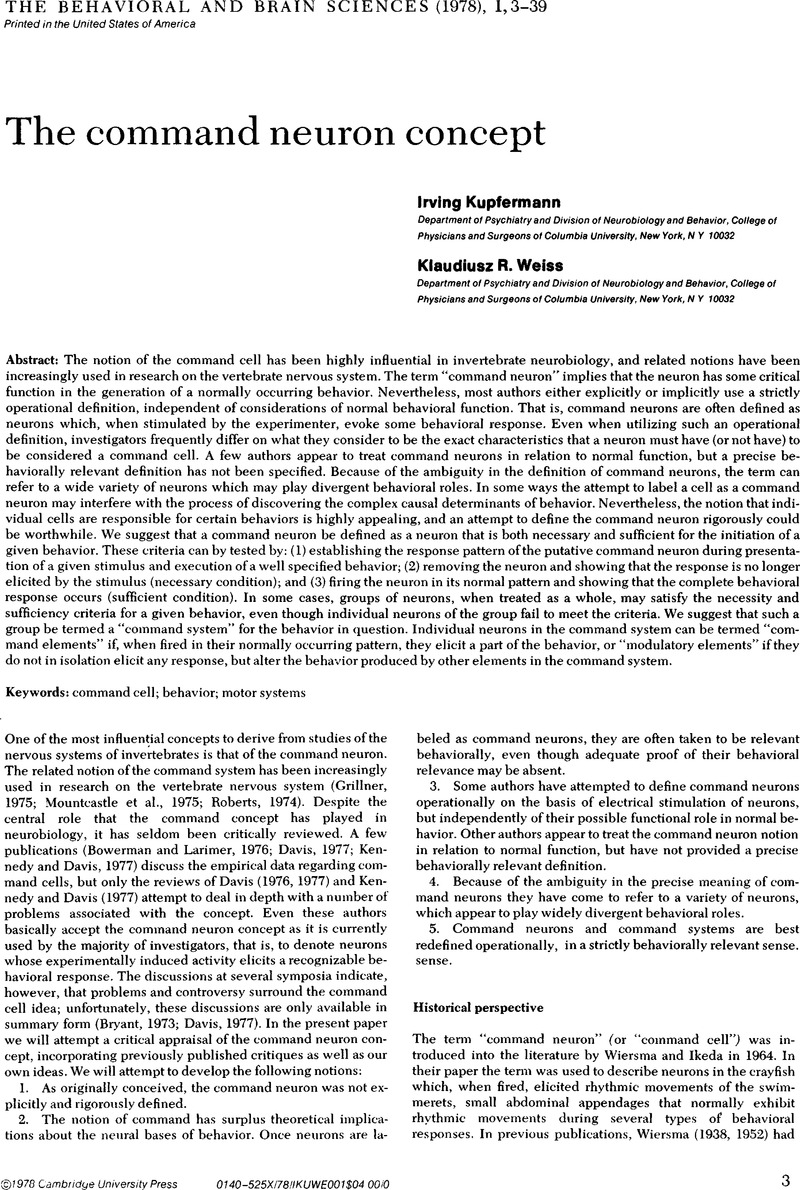Crossref Citations
This article has been cited by the following publications. This list is generated based on data provided by Crossref.
Heath, Robert G.
1982.
Panksepp's psychobiological theory of emotions: Some substantiation.
Behavioral and Brain Sciences,
Vol. 5,
Issue. 3,
p.
432.
de Sousa, Ronald
1982.
Introspection as the Rosetta stone: Millstone or fifth wheel?.
Behavioral and Brain Sciences,
Vol. 5,
Issue. 3,
p.
428.
Lutz, Catherine
1982.
Introspection and cultural knowledge systems.
Behavioral and Brain Sciences,
Vol. 5,
Issue. 3,
p.
439.
Anisman, Hymie
and
Zacharko, Robert M.
1982.
Assessing internal affairs.
Behavioral and Brain Sciences,
Vol. 5,
Issue. 3,
p.
422.
Izard, C. E.
1982.
From stimulus-bound emotive command systems to drive-free emotions.
Behavioral and Brain Sciences,
Vol. 5,
Issue. 3,
p.
433.
Globus, Gordon G.
1982.
Can phenomenology contribute to brain science?.
Behavioral and Brain Sciences,
Vol. 5,
Issue. 3,
p.
430.
Delgado, José M. R.
1982.
Animal and human emotionality.
Behavioral and Brain Sciences,
Vol. 5,
Issue. 3,
p.
425.
de Rivera, Joseph
1982.
Relating experience to the brain.
Behavioral and Brain Sciences,
Vol. 5,
Issue. 3,
p.
427.
Fonberg, Elzbieta
1982.
Emotions are objective events.
Behavioral and Brain Sciences,
Vol. 5,
Issue. 3,
p.
429.
Klinger, Eric
and
Kemble, Ernest D.
1982.
Generality and specifics in psychobiological theory of emotions.
Behavioral and Brain Sciences,
Vol. 5,
Issue. 3,
p.
437.
Toates, Frederick M.
1982.
The rat as hedonist – A systems approach.
Behavioral and Brain Sciences,
Vol. 5,
Issue. 3,
p.
446.
Plutchik, Robert
1982.
Only four command systems for all emotions?.
Behavioral and Brain Sciences,
Vol. 5,
Issue. 3,
p.
442.
Ursin, Holger
1982.
Introspection and science: The problem of standardizing emotional nomenclature.
Behavioral and Brain Sciences,
Vol. 5,
Issue. 3,
p.
447.
Siegel, Allan
1982.
On the nature of specific hard-wired brain circuits.
Behavioral and Brain Sciences,
Vol. 5,
Issue. 3,
p.
443.
Vanderwolf, C. H.
and
Goodale, M. A.
1982.
Does introspection have a role in brain-behavior research?.
Behavioral and Brain Sciences,
Vol. 5,
Issue. 3,
p.
448.
Averill, James R.
1982.
Emotions: Hard- or soft-wired?.
Behavioral and Brain Sciences,
Vol. 5,
Issue. 3,
p.
424.
Arnold, Magda B.
1982.
Emotions – inferences from hypothetical hypothalamic circuits?.
Behavioral and Brain Sciences,
Vol. 5,
Issue. 3,
p.
423.
Royce, Joseph R.
1982.
On the complexity of emotion.
Behavioral and Brain Sciences,
Vol. 5,
Issue. 3,
p.
443.
Solomon, Robert C.
1982.
Emotional cookbooks.
Behavioral and Brain Sciences,
Vol. 5,
Issue. 3,
p.
444.
Jaynes, Julian
1982.
A two-tiered theory of emotions: Affect and feeling.
Behavioral and Brain Sciences,
Vol. 5,
Issue. 3,
p.
434.





